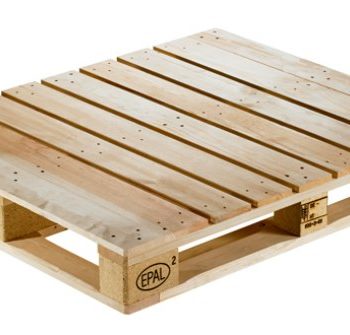What are the Standard Sizes of Euro Pallets?
05 Feb 2020

There are many different types of standard Euro pallet sizes. This is due to the amount of different industries that use wooden pallets around the world. Euro pallet dimensions can vary depending on which country you are located in, but with our handy guide you should be able to distinguish the euro pallet dimensions you require for your next shipment.
Standard Sizes of Euro Pallets
Different industries built pallets however they saw fit, and almost everywhere there are several “standard” sizes.
The two most numerous today are the American Grocers Manufacturers’ Association pallet of 40”x48” (1016x1219mm) and the European 800x1200mm EUR 1.
In the UK a metric approximation to the American pallet (1000x1200mm) was eventually designated the EUR 2.
There is some logic to these sizes. Euro pallets were designed to fit into trains and pass through doorways (the typical door being 850x2000mm).
America and the UK historically trade by sea, so their standard pallets stack into ISO shipping containers with the least leftover space – about 3-5% compared to 15% using EUR 1.
ISO and ECU authorities also recognise a EUR 3 standard. This has the same dimensions as EUR 2 but is constructed in the other direction, with width and length reversed. The EUR 3 often has a higher load-bearing capacity (1920 kg instead of 1470kg).
The EUR 6 is half the EUR 1 (800×600), and there is a 600×400 quarter pallet and so on.
There are moves to introduce shipping containers matched to the EUR-pallet, but numerous sizes will be around for a long time yet.
Pallet Pools
To overcome standardisation problems and logistical waste and delay, pallet pooling companies emerged.
They also provided the opportunity to apply improved quality control, grading, recycling, repairs and pest control.
Pallets that conform strictly to European standards qualify for the European Pallet Pool (EPP) that organises a pallet for pallet exchange system.
This is extremely useful for shipping companies and for compliance with the UK Waste Framework Directive promoting reuse of packaging and recycling.
EUR-Pallet Quality Marks
On the left corner should be the EPAL logo. On the central leg a code indicates the manufacturer and verifier. There could be a special nail to record an accredited repair.
Other numbers denote the production year and type of wood; on the right corner there are EPAL and EUR logos. Grading marks may be added by pooling companies.

The International Standard for Phytosanitary Measures requires pallets shipped internationally to be treated to prevent invasive diseases and species like the Asian long-horn beetle and Pinewood nematode (ISPM 15).
Heat-treated timber is designated by an “HT” near the logo of the International Plant Protection Convention (IPPC). Pallets fumigated with methyl bromide were marked “MB”, but this method is now banned.
Construction
Pallets vary by material (hardwoods, softwoods, fibreboard, metals, plastic) and construction. A skid is a pallet without deckboards. A stillage is one with sides.
The construction determines whether they can admit forklifts and pallet jacks from two sides or four. In four-way block pallets, for example, upright edge stringers are replaced by block supported flat stringer boards, leaving space for forks beneath.
Pallets are also often moulded from recycled plastic. These are weather resistant, rot-proof, durable, easy to clean, lightweight and fire-retardant, but wood is cheaper and remains the standard material for Euro Pallets.
Euro Pallet History
Amazingly, wooden pallets were used for transporting goods as far back as ancient Egypt and Mesopotamia. So far as Western history is concerned, the first patent was filed in 1924.
Although it feels like they’ve been around forever, they didn’t take off until the 1960s, at the same time as “juggernaut” lorries and container ships. Standard Euro pallets were defined in 1961.
Euro Pallet Prices
At Associated Pallets, we have a wide selection of new and used pallets available in euro pallet dimensions. To order yours today choose the type of pallet you want and select the euro pallet dimension you require. We deliver our pallets across the UK, EU and internationally. If you are a UK customer and order the wooden pallets before noon, you can have the option of next day delivery. Should you have any questions for our team, please call us at 03301 757 766.


